The modern kitchen is a marvel of innovation and efficiency, and at the heart of this transformation lies the food processor.
A relatively recent invention, the food processor has its roots in the early 20th century. Before its advent, tasks like chopping, grinding, and mixing were labor-intensive and time-consuming.
The need for a machine that could handle these tasks with ease and precision gave birth to the first prototypes of what we now know as the food processor.
Pierre Verdun, a French catering company salesman, is often credited with inventing the food processor in the 1960s. He observed the tedious tasks chefs had to perform and envisioned a single device that could do it all.
His invention, initially called "Le Magi-Mix", was a hit in professional kitchens.
By the 1970s, the food processor had been introduced to the domestic market, forever changing the way we cook and prepare food.
Today, the food processor is an indispensable tool in kitchens worldwide.
Its multifunctional capabilities, from slicing vegetables to kneading dough, have made it a beloved appliance for both professional chefs and home cooks.
The importance of modern food processors used in today's kitchen cannot be overstated.
They not only save time and effort but also open up a world of culinary possibilities, allowing us to experiment and create dishes that were once deemed too complex or time-consuming.
As we delve deeper into understanding its workings, we'll appreciate even more the genius behind this modern kitchen marvel.
Short Summary
- Understanding the fundamental components and operation of food processors, including the variety of blades and attachments.
- Exploring the diverse sizes and types of food processors available.
- Addressing common queries and offering practical advice for maximizing food processor efficiency.
The Basic Components of a Food Processor
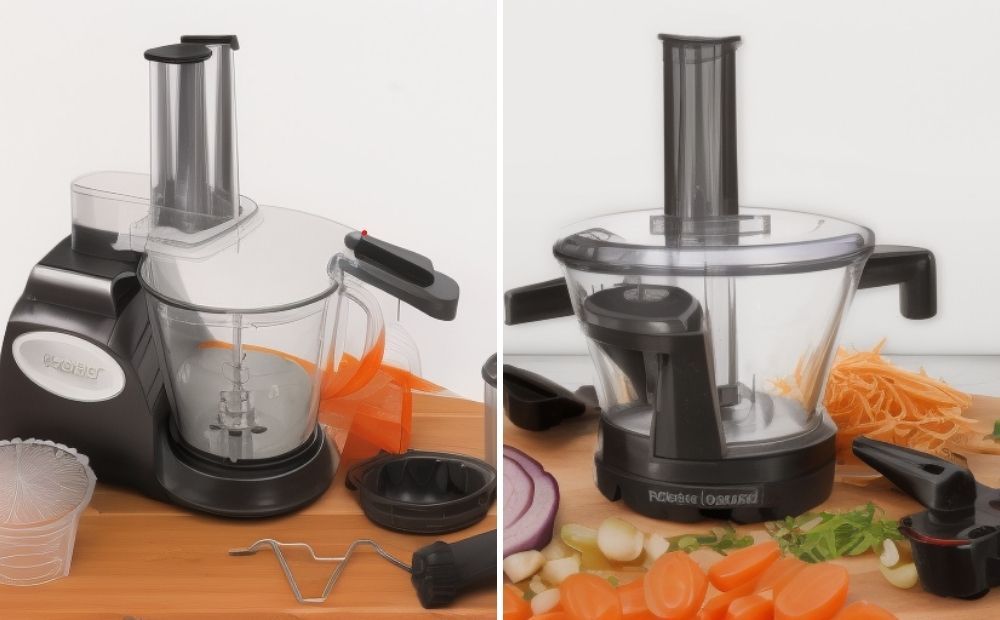
The basic food processor components
The food processor, a staple in many kitchens, is a versatile appliance that simplifies a myriad of culinary tasks.
But what makes it so efficient and user-friendly? Let's break down its basic components and understand the role each plays in the food processor's operation.
Motor: The Heart of the Processor
Central to the food processor's functionality is its motor. Often housed in the base of the unit, the motor is the powerhouse that drives the blades and discs.
Depending on the model and brand, most food processors come with varying motor strengths, suitable for tasks ranging from chopping soft fruits to kneading tough dough.
A robust motor ensures consistent performance, longevity, and the ability to handle a variety of foods without strain.
Bowl: Where the Action Happens
The bowl is the container where ingredients chop food are placed for processing. Typically made of durable, transparent plastic, it allows users to monitor the progress of the food being processed.
Some high-end models offer shatterproof and heat-resistant bowls.
It's essential to ensure the bowl locks into place securely, forming a tight seal with the base to prevent any spillage or mishaps during operation.
Lid with Feed Tube: Safety and Functionality
The lid, much like the bowl, is crucial for safety. It ensures that food remains within the food processor bowl while it's in operation, preventing splatters and potential injuries.
Incorporated into the lid is the feed tube, a cylindrical chute through which ingredients are added during processing.
This design allows users to introduce ingredients gradually, ensuring even chopping or blending.
Additionally, most feed tubes come with a pusher that fits snugly, assisting in safely guiding food down the tube and onto the blade or disc.
Blades and Discs: The Cutting Tools
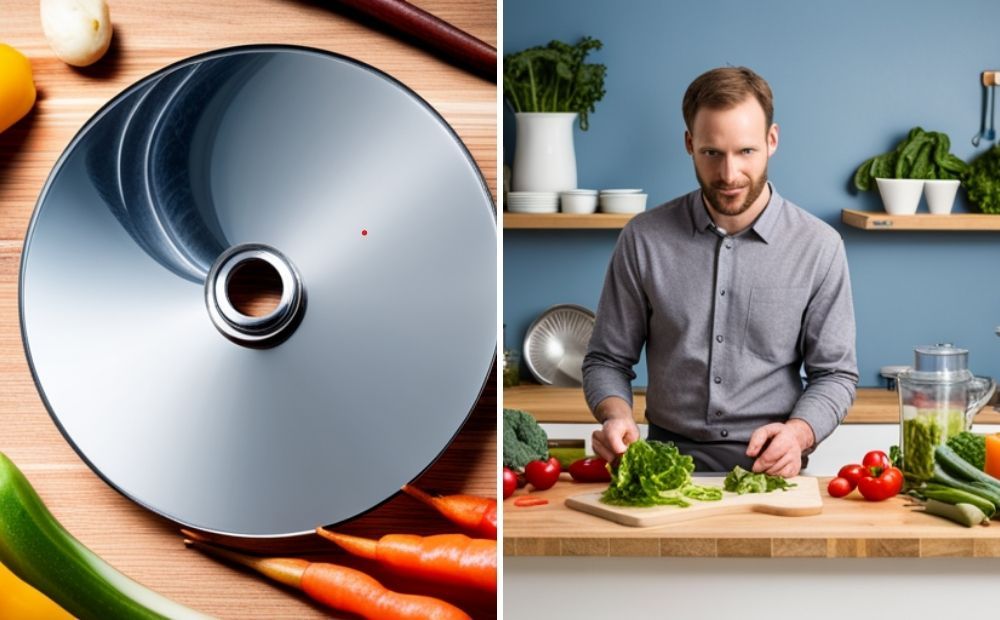
Food processor and cutting disc
Arguably the most vital components, the blades and discs determine the kind of tasks a food processor can perform.
The standard S-shaped blade sits at the bottom of the bowl and is perfect for chopping, mixing, and puréeing. Disc blades, on the other hand, are positioned at the top of the bowl and are designed for slicing, grating, and shredding.
These blades and discs are typically made of stainless steel, ensuring sharpness, durability, and resistance to rust.
Over time, brands have introduced various specialized attachments, expanding the repertoire of tasks a food processor can handle.
The efficiency and versatility of a food processor lie in the synergy of its basic components.
Each part, from the motor to the blades, plays a pivotal role in ensuring that this kitchen marvel remains an indispensable tool for chefs and home cooks alike.
Different Blades and Attachments in a Food Processor
The versatility of a food processor largely depends on its array of blades and attachments. These specialized tools are designed to handle a myriad of culinary tasks, making the food processor an indispensable appliance in both professional and home kitchens. Let's delve into the most common food processor blades and attachments and their specific functions.
S-blade: Puréeing and Mixing
The S-blade, often referred to as the Sabatier blade, is the most common blade found in food processors. Shaped like the letter 'S', this blade sits at the bottom of the food processor bowls or bowl and is the standard food processing blade that every model comes with. Made of stainless steel, its sharp edges make it perfect for a range of tasks:
- Puréeing: Whether you're making a velvety soup, baby food, or a smoothie, the S-blade ensures a consistent and smooth texture. Its design pulls ingredients towards the center, ensuring even processing.
- Mixing: From combining wet and dry ingredients for a cake batter to blending dips like hummus or guacamole, the S-blade mixes ingredients efficiently and uniformly.
Dough Blade: Kneading Bread
Slightly less sharp than the S-blade, the dough blade is designed specifically for kneading. Made of either plastic or metal, its unique shape ensures:
- Effective Kneading: The blade pushes and folds the dough, mimicking the action of hand kneading bread dough. This develops the gluten in the dough, leading to fluffy and soft bread.
- Less Heat: Kneading can generate heat, which might not be ideal for some dough types. The dough blade minimizes this heat, ensuring the dough remains at an optimal temperature.
Disc Blades: Slicing and Shredding
Disc blades, or simply discs, are positioned at the top of the bowl and don't reach its bottom. They come in various types, each designed for a specific task:
- Slicing Disc: Equipped with a sharp edge, this disc can slice vegetables, fruits, and even some meats. Depending on the model, you might be able to adjust the thickness of the slices.
- Shredding or Grating Disc: Perfect for grating cheese, shredding vegetables for coleslaw, or even making breadcrumbs, this disc offers a coarse or fine shred based on its design.
Whipping Tools: For Creams and Batters
While not as common as the blades mentioned above, whipping tools are a valuable addition to a food processor's arsenal:
- Whisk Attachment: Similar to a hand mixer's whisk, this tool is perfect for whipping cream, beating eggs, or making meringues. It incorporates air into the mix, resulting in a light and fluffy texture.
- Batter Mixer: Some food processors come with a special attachment for mixing pancake or crepe batter. It ensures a lump-free mixture, leading to perfect pancakes every time.
The true prowess of a food processor lies in its blades and attachments. They transform a simple motorized kitchen appliance, into a culinary powerhouse, capable of handling a vast array of tasks.
By understanding the function of each blade and attachment, users can harness the full potential of their food processor, elevating their cooking and baking to new heights.
Different Sizes Of Food Processors
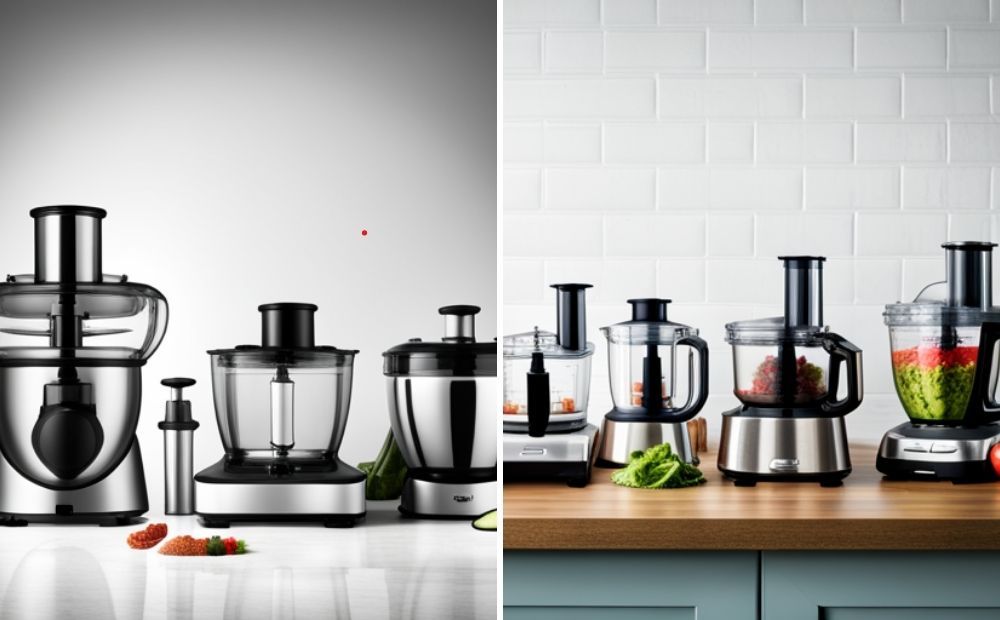
Different sizes of food processors
Food processors, often dubbed the kitchen's Swiss Army knife, come in a variety of sizes to cater to different culinary needs and kitchen spaces.
The size of a food processor not only dictates its capacity but also the range of tasks it can handle efficiently.
Some models can also help in making citrus and vegetable juice. Let's explore the three primary sizes of food processors and their unique advantages.
Mini or Small-Sized Processors:
Compact and lightweight, mini processors typically have a capacity of up to 3 cups. They are perfect for:
- Small Tasks: Whether it's chopping a handful of herbs, grinding nuts, or making a small batch of salsa, these processors handle small quantities with ease.
- Space Saving: For those with limited kitchen counter space or for those who prefer a minimalist kitchen, mini processors are an ideal choice due to their compact footprint.
- Portability: Their small size makes them easy to move around, store, or even travel with if needed.
Medium-Sized Processors:
With a capacity ranging from 4 to 8 cups, medium-sized processors are the middle ground, offering a balance between capacity and footprint. They are suitable for:
- Everyday Cooking: Ideal for regular cooking tasks like chopping vegetables, blending soups, or making pizza dough enough for a family-sized pizza.
- Versatility: They often come with multiple attachments, allowing for a range of tasks without being as bulky as the larger models.
Large or Full-Sized Processors:
Boasting a capacity of 9 cups and above, large processors are the workhorses of the kitchen. They and many food processors are perfect for:
- Bulk Processing: Whether it's preparing ingredients for a party, making large batches of sauces, or kneading bread dough together for multiple loaves of bread, these processors handle large quantities efficiently.
- Advanced Features: Many large processors come with a plethora of attachments and settings, making them suitable for advanced culinary tasks.
- Professional Use: Their capacity and versatility make them a favorite in professional settings like restaurants or bakeries.
The size of a food processor plays a pivotal role in determining its functionality and suitability for a particular kitchen.
Whether you're a solo cook, a home chef catering to a family, or a professional, there's a food processor size tailored to meet your needs.
Choosing the right size ensures that you get the most out of this versatile appliance, making your culinary adventures both enjoyable and efficient.
Different Types Of Food Processors
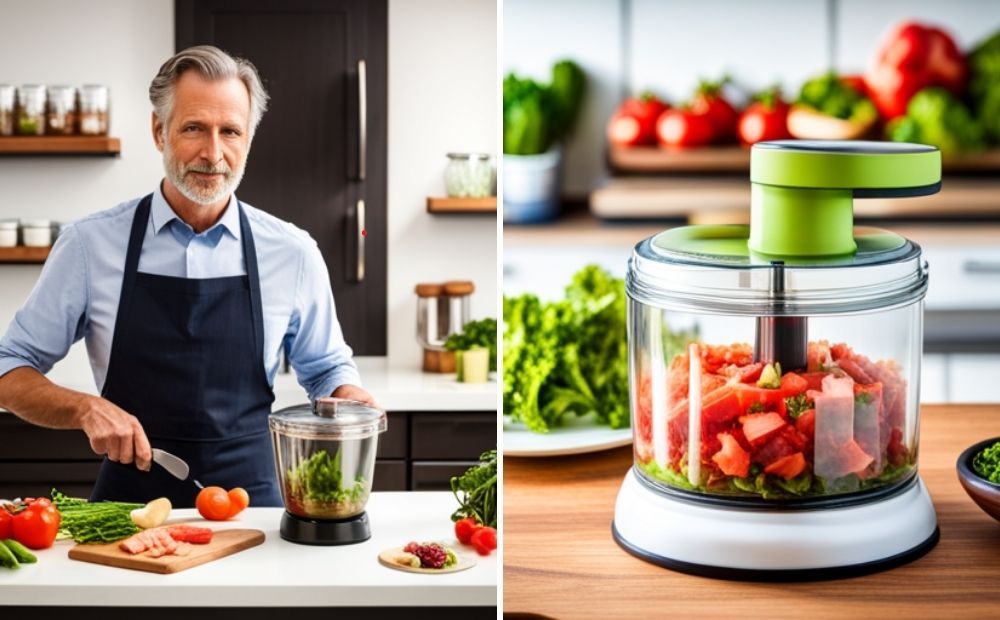
Electric and mannual food choppers
In the realm of kitchen appliances, food processors stand out as one of the most versatile tools.
They have evolved over the years to cater to various culinary needs and preferences. From manual choppers to sophisticated electric models, there's a food processor for every task and kitchen.
Let's delve into the different types of food processors and their unique features.
Manual Food Chopper:
A throwback to simpler times, the manual food chopper is a hand-powered device, often relying on a string-pull mechanism or a hand slap action.
- Functionality: Best suited for chopping vegetables, nuts, and herbs. It's perfect for small tasks like making salsa, guacamole, or chopping onions without tears
- Advantages: It doesn't require electricity, making it eco-friendly and portable. It's also quieter than electric models and easy to clean.
- Limitations: It may not handle harder foods or large quantities efficiently.
Electric Food Chopper:
A step up from the manual chopper, the electric food chopper is compact but powered by electricity.
- Functionality: Ideal for chopping and mincing tasks. It can handle harder foods like nuts and can also puree soft foods.
- Advantages: Faster and more consistent than manual choppers. It's perfect for quick tasks and doesn't occupy much counter space.
- Limitations: It has a smaller capacity and fewer functionalities compared to full-sized food processors.
Electric Food Processor:
The electric food processor is the most common type found in kitchens, known for its versatility.
- Functionality: From chopping, slicing, and grating to kneading dough and blending, it can handle a plethora of tasks. It often comes with multiple attachments and settings.
- Advantages: It's a true kitchen workhorse, reducing prep time significantly. The various attachments make it suitable for a wide range of culinary tasks.
- Limitations: It's bulkier than choppers and might be overkill for those who cook occasionally or have limited kitchen space.
Food Processor & Blender Combo:
A hybrid appliance, this combines the functionalities of both a food processor and a blender.
- Functionality: Along with standard, food preparation and processing tasks, it can blend smoothies, soups, and even crush ice. Some models come with separate jars for blending and processing.
- Advantages: It's a space-saver, eliminating the need for two separate appliances. It's cost-effective for those setting up a new kitchen.
- Limitations: While it offers dual functionality, it might not match the efficiency of two standalone devices dedicated to their respective tasks.
Handheld Food Processor:
A fusion of portability and electric power, the handheld food processor is often battery-operated.
- Functionality: It's designed for quick tasks like chopping small quantities of herbs or vegetables, making dressings, or whipping cream.
- Advantages: It's highly portable, perfect for on-the-go tasks or for those who prefer not to bring out larger appliances for small tasks. It's also easy to clean and store.
- Limitations: It has a limited capacity and might not handle tougher foods or complex tasks efficiently.
KitchenAid® 13-Cup Food Processor: Getting Started | KitchenAid
Food Processors FAQs
How to clean and use a food processor?
Cleaning a food processor is straightforward. First, unplug the device. Remove the blade and bowl, then wash them with warm soapy water. For the base, wipe it down with a damp cloth. Some parts might be dishwasher-safe, but always check the manufacturer's instructions.
Can I process hot foods?
It's advisable to let hot foods cool down slightly before processing. Extremely hot ingredients can cause the plastic components to warp or even crack. Additionally, steam buildup might push the lid off, leading to potential spills or burns.
What can't you put in a food processor?
Avoid processing extremely hard foods like bones or coffee beans, unless your model specifies that it can handle them. Also, refrain from overloading the bowl, as this can strain the motor and result in uneven processing.
Secrets and Suggestions
Maximizing the efficiency of your processor:
- Always ensure the bowl and lid are locked in place before starting.
- For even chopping, cut ingredients into uniform sizes before processing.
- Pulse ingredients for better control and consistency.
Safety precautions to keep in mind:
- Never insert fingers or utensils into the processor while it's running.
- Always use the provided pusher to guide ingredients through the feed tube.
- Ensure the blade has completely stopped before removing the lid.
Maintenance and storage advice:
- Regularly check the blade's sharpness. A dull blade can strain the motor.
- Store blades and attachments separately to prevent them from becoming blunt.
- If your processor isn't used frequently, store it in a cool, dry place to prevent any potential damage or wear.
In the market for a food processor for small spaces? Check out our article for our top picks for mini food processors.
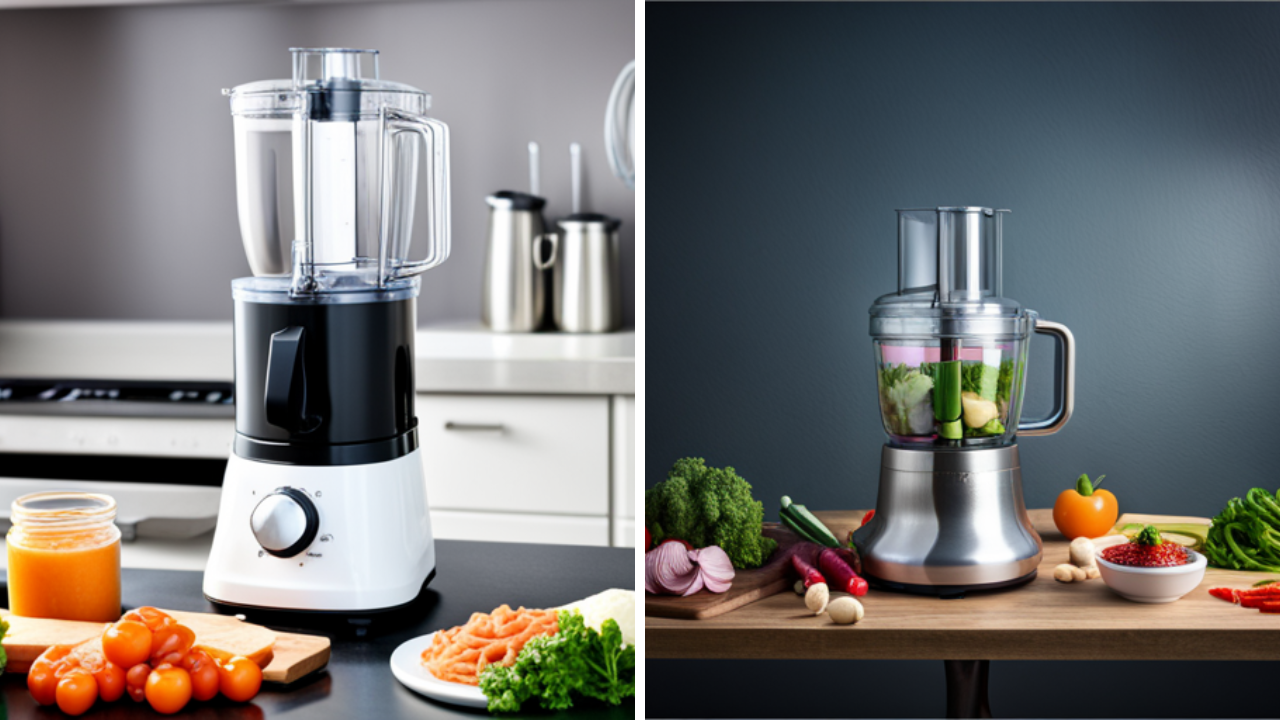
You may also enjoy our articles on the best food processor for dough and the best manual food processor.
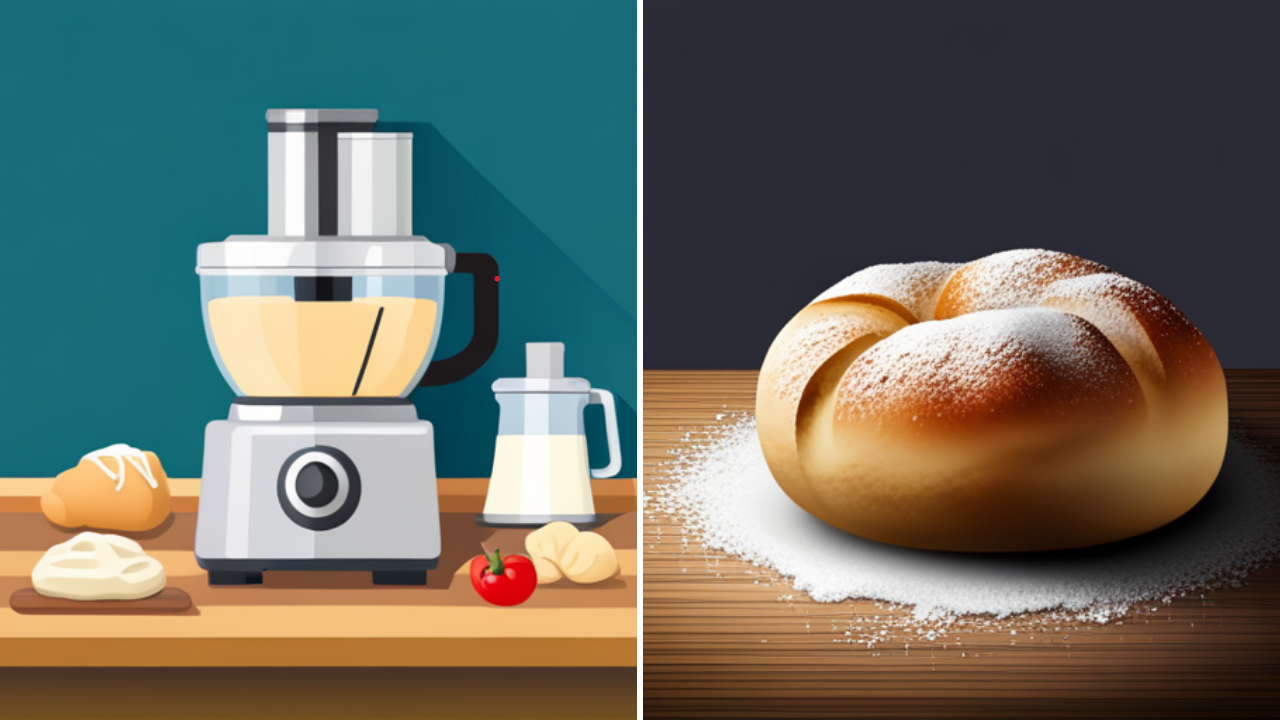
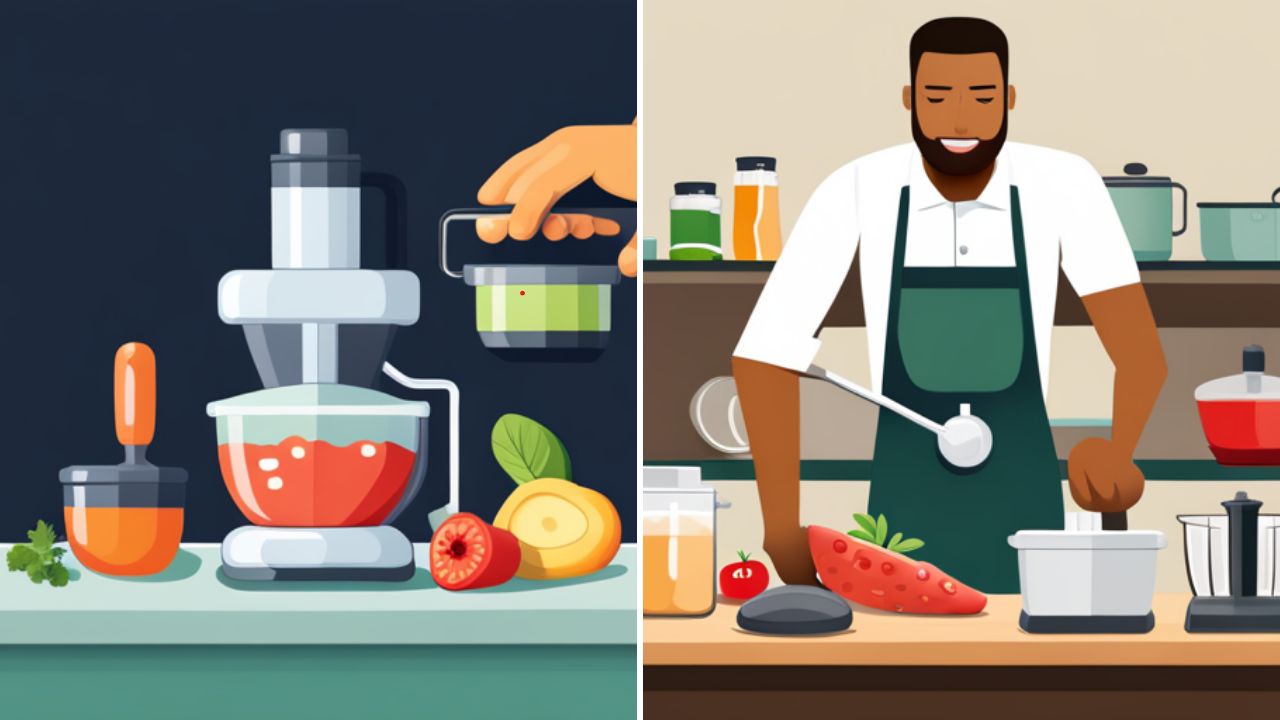
The world of food processors is vast and varied. Each type brings its unique set of advantages to the table, catering to different needs and preferences.
Whether you're a professional chef, a home cook, or someone who cooks occasionally, there's a food processor tailored for you.
Understanding the functionalities and limitations of each type can guide you in making an informed decision, ensuring that you choose the perfect companion for your culinary adventures.










